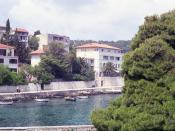The peaceful dissolutions of Finland and Sweden and Czechoslovakia into what we now know to be The Czech Republic and Slovakia should have been a model for Yugoslavia. Due to several factors and not only history between each of the nations involved it has progressed from strong nationalistic sentiment to episodes of violent ethnic cleansing done by all factions included. This region has been a crossroad for Europe and an important strategic point between the West and The East from the Byzantine era to The Cold War era. History of the Balkans has been disputed for decades because of the attempt to establish historical precedence and thus justify national wish to secede from the Yugoslavian republic or justify territorial claims by yet another nation. These movements have sparked numerous misconceptions as to why this region has seen such horrid acts of violence perpetrated on civilians. Aggression and antagonism between Serbs, Croats and Muslims is of relatively recent nature, contrary to popular belief.
Violent nationalistic movements are the result of Communist suppression of any national identity and Post Communist struggles between Slobodan Milosevic, Dr. Franjo Tudjman and Alija Izetbegovic for power in their respective territories.
History is the integral factor in determining why this region has been subjected to this type of national strife that has turned into international more than once. The Ex-Socialist Federative Republic of Yugoslavia was made of six republics and two autonomous regions, which were a home to multiple nations. Both Latinic and Cyrillic were considered to be official scripts, Yugoslavia also recognized the Orthodox Christian Faith (most populous1), Catholic Christian (2nd in number of followers1) and followers of Islam (who comprised the 3rd major population ).
These three religions were the most influential in the former Yugoslavia and while the Serbs and the Croats were...


